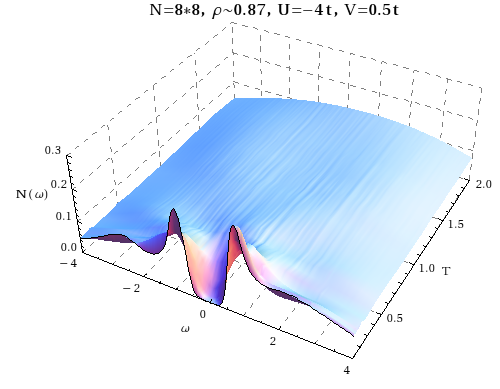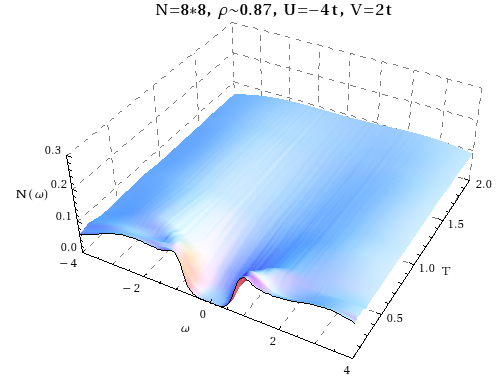Trivedi Group
Site Navigation
Quantum Phase Transitions Driven by Disorder
Disordered Superconductors:
When a superconducting material is deposited as a thin film, it may behave as an insulator due to disorder and quantum fluctuations. The nature of this superconductor-insulator transition (SIT) is still not completely understood. According to one school of thought, the Cooper pairs break up into their constituent fermions leading to a metallic phase near the SIT. An alternative viewpoint holds that the Cooper pairs remain bound as “composite bosons”, and that the SIT is caused by phase fluctuations that destroy long-range phase coherence between superfluid patches. We go beyond previous studies by including quantum and thermal phase fluctuations and calculating frequency-dependent quantities such as the density of states. For example, we show that the single-particle gap is robust for both superconducting and insulating phases. Increasing temperature causes the gap to fill up, producing a pseudogap. This pseudogap region grows with disorder. (K. Bouadim, Y. L. Loh and M. Randeria)


V=0.5t (Superconductor)
V=2 (Insulator)
Comparison of the density of states N(ω) for one disorder realisation but different disorder amplitudes,
as a function of temperature.
Only the superconductor in low disorder case (left panel) shows sharp peaks at the gap edges.
Both exhibit a pseudogap behavior.The temperature evolution of the magnitude of the gap is similar between these cases,
indicating a common physical origin.
Larkin-Ovchinnikov Physics in Superconducting Films in Zeeman Fields:
In a superconducting film in a Zeeman field, the competition between pairing and spin polarization drives a quantum phase transition from a superconducting state to a normal state. This is usually assumed to be a first-order transition occurring at the Chandrasekhar-Clogston field hCC = 0.71 Δ0. However, the transition may actually proceed via a Larkin-Ovchinnikov state, even in the presence of disorder. A disordered Larkin-Ovchinnikov state is characterized by microscale coexistence of pairing and polarization: a sufficiently large Zeeman field induces magnetization in irregular domain walls, at which the pairing order parameter changes sign. In addition, we have found that the spectral function (density of states) contains weight within the gap due to the "emergent magnetic impurities" at the domain walls. The spectral function is important because it is closely related to the tunneling conductance, which is an important experimental observable. We propose that "dirty LO physics" may help to explain the excess zero-bias conductance in recent experiments. (Y. L. Loh)
.png)
Magnetization m(r), pairing density F(r), and up-spin, down-spin, and total densities of states for a 2D attractive Hubbard model exhibiting a dirty LO state.